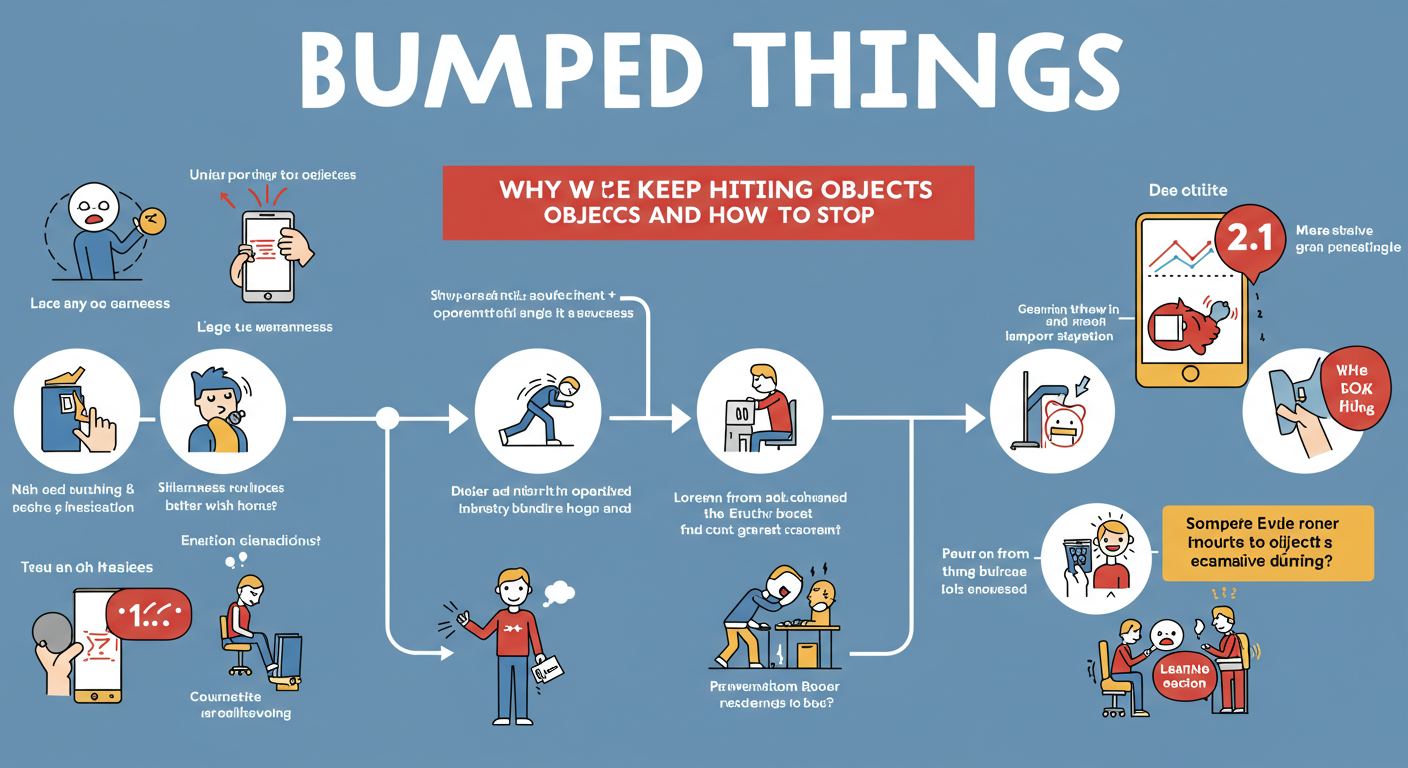We’ve all been there—bumping into a table leg, knocking a glass off the counter, or walking into a doorframe. These everyday bumped things moments might seem harmless, but when they happen frequently, they could signal something deeper. From distractions and poor lighting to health issues and stress, there are many reasons why we end up running into objects.
In this guide, we’ll explore why bumped things occur, how to recognize the common causes, and what steps you can take to reduce these accidents and improve your overall awareness and safety.
Understanding the Concept of Bumped Things
The phrase bumped things refers to unintended physical contact with objects, often resulting in minor pain, embarrassment, or damage. It includes situations like:
-
Hitting your shoulder against a doorframe
-
Tripping over furniture you didn’t notice
-
Knocking items off shelves
-
Walking into people in public spaces
These incidents aren’t just clumsy moments—they may reflect how your brain and body process your surroundings.
Common Reasons People Experience Bumped Things
1. Lack of Focus or Distraction
One of the most common reasons people bump into things is because they’re not paying attention. Whether you’re scrolling through your phone, deep in thought, or multitasking, your mind isn’t fully aware of your environment.
Even brief distractions can lead to knocking over objects or misjudging distance.
2. Vision Impairment
Uncorrected or undiagnosed vision problems can increase your chances of bumping into furniture, walls, or people. If your peripheral vision is weak, you may not notice obstacles until it’s too late.
Signs of vision-related bumped things include:
-
Difficulty in dim lighting
-
Misjudging distance between objects
-
Trouble with depth perception
3. Poor Spatial Awareness
Spatial awareness is your brain’s ability to judge distance and position. When this is off—even slightly—you might miscalculate how much space you have, causing unintentional bumps.
Common causes of reduced spatial awareness include:
-
Fatigue
-
Anxiety
-
Sleep deprivation
-
Neurological disorders
Health Conditions That May Lead to Frequent Bumped Things
While occasional clumsiness is normal, frequent occurrences of bumping into things might indicate underlying health concerns. These include:
1. Dyspraxia
Also known as Developmental Coordination Disorder, dyspraxia affects coordination and movement. It’s often diagnosed in children but can persist into adulthood.
2. Parkinson’s Disease
Early symptoms of Parkinson’s include poor coordination and balance. People may notice they are bumping into furniture or having trouble moving smoothly through spaces.
3. Vestibular Disorders
These affect balance and are often linked to issues in the inner ear. People with vestibular problems may feel dizzy or unsteady, increasing the risk of colliding with objects.
4. Stroke or Brain Injury
Individuals recovering from stroke or traumatic brain injury may experience difficulties with spatial processing, causing frequent bumped things episodes.
Environmental Factors That Increase Bumping Incidents
Not all bumping incidents stem from personal factors. Your surroundings play a big role too.
1. Cluttered Spaces
A home or office with tight walkways, scattered objects, or poorly placed furniture increases the likelihood of tripping or bumping.
2. Poor Lighting
Dim or flickering lights can make it hard to spot low-lying objects or narrow doorways.
3. Awkward Furniture Layout
Furniture that’s too large for a room or arranged without flow in mind can create frequent obstacles, especially for children or the elderly.
Psychological Causes of Bumped Things
Your mental state affects how you move through the world. People under high stress or anxiety often report more physical accidents and near-misses.
1. Stress and Fatigue
Mental exhaustion leads to a reduced ability to process your environment. The brain slows down in making quick physical adjustments, resulting in more bumps and mishaps.
2. Overthinking
Ironically, worrying too much about making mistakes can cause you to become stiff or hesitant—both of which lead to accidents.
Tips to Reduce the Frequency of Bumped Things
1. Declutter Your Living Space
Create clear pathways around your home or office. Remove objects that you don’t need, especially from walkways and corners.
2. Improve Lighting
Use bright, consistent lighting in hallways, kitchens, and stairs. Nightlights can help reduce bumps in the dark.
3. Get Regular Eye Exams
Routine vision checks help catch changes in eyesight before they lead to injuries. Prescription updates or corrective lenses may solve the problem altogether.
4. Be More Mindful
Practice being present in the moment. Whether you’re walking through your home or working at your desk, slowing down just a bit can help you avoid unnecessary bumps.
5. Consider Professional Help
If bumping into things is a regular issue, speak with a healthcare provider. Physical therapists, occupational therapists, or neurologists can evaluate coordination, balance, and cognitive processing.
When Bumped Things Might Be Serious
Sometimes, frequent bumped things events signal a deeper issue. Consider seeing a doctor if:
-
You notice balance issues or frequent dizziness
-
Bumping becomes more intense or leads to injury
-
You have a sudden increase in such incidents
-
You’re experiencing memory lapses or confusion
In these cases, early intervention can prevent accidents and improve quality of life.
Conclusion: Understanding and Managing Bumped Things in Everyday Life
Bumping into things occasionally is part of being human. But when it starts happening often, it’s worth exploring the reasons. Whether it’s vision problems, a cluttered space, stress, or something more serious, identifying the root cause can help you make safer choices.
By being more mindful of your surroundings, organizing your environment, and paying attention to how your body moves, you can significantly reduce these incidents. The phrase bumped things may sound simple, but it holds a deeper story about how we interact with the world around us—and how small changes can make a big difference.

